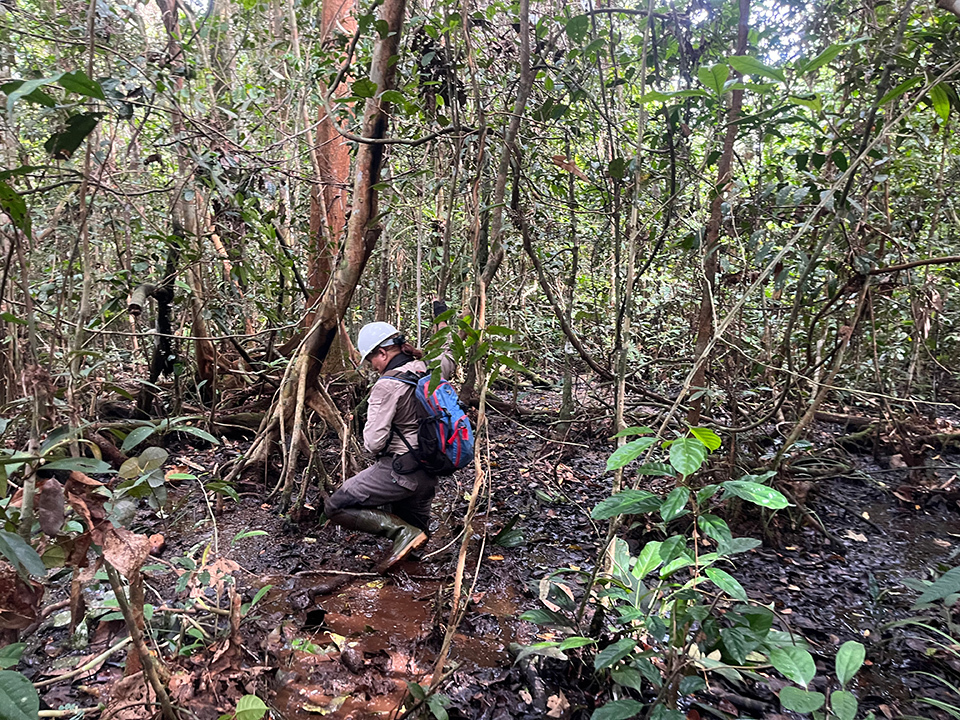To help prevent the degradation of peatlands—one cause of forest fires in Indonesia—a Japanese forestry company has taken action to establish a unique peatland management system that integrates environmental conservation with economic feasibility. It now aims to expand this solution on a global scale.

Battling the 2015 fires in Indonesia. AP/AFLO
In 2015, a massive forest fire broke out in Indonesia, destroying approximately 46,000 square kilometers of forest as well as the rare species of fauna and flora in it. The fire released 1,750 million metric tons of CO2 equivalent (mtCO2e)—corresponding to 5.1% of global CO2 emissions that year—and 43 million people were exposed to unusually high levels of smoke.

A tropical peatland conservation area in Indonesia managed by Sumitomo Forestry Co., Ltd.
Tropical peatlands, widely distributed across Indonesia, are areas where dead vegetation has accumulated in water without completely decomposing. Though peatlands (including those in non-tropical climatic zones) make up only 3% of the Earth’s land area, they store 30% of the world’s soil carbon. However, when peatlands are excessively drained for forestry or agricultural purposes, the peat—which is essentially a mass of carbon—not only decomposes and emits CO2, but also dries out and becomes highly flammable.

A tropical peatland conservation area in Indonesia managed by Sumitomo Forestry Co., Ltd.
Indonesia has a tradition of slash-and-burn farming, but on dried peatlands, the practice can be fatal. Fires that spread rapidly through underground peat are difficult to extinguish and release these centuries-old carbon stores in the form of massive amounts of CO2 entering the atmosphere.
Sumitomo Forestry Co., Ltd., is a major Japanese forestry company that has been working on peatland conservation since 2009, well before the large-scale fires in 2015. The company has been pursuing sustainable forestry in Indonesia, striving to balance conservation of the peatlands with economic feasibility. Notably, no fire occurred in the concessions managed by Sumitomo Forestry during the 2015 fire crisis.
One of the company’s key features is its strict management of groundwater levels in tropical peatlands. Prior to starting its forestry business, the company spent five years conducting detailed surveys of the local terrain, as well as peat depth and distribution. Based on the results, they zoned suitable areas for working and conservation forests, and meticulously designed and built various water-related infrastructure, such as canals and dams. The company subsequently established a system to maintain appropriate groundwater levels in each zone throughout the year by controlling the flow of water stored during the rainy season. Out of the 1,560 square kilometers of concessions managed by the company, only about 200 are used for afforestation, and the revenue from the timber produced in that area covers conservation costs in the other zones.
Based on detailed surveys, areas are divided into working forests, a hydrobuffer, and conservation forests to maintain valuable tropical peatlands and their ecosystems while producing timber as an economic activity. The implementation of satellite technology is also underway.
Communication with local residents—who rely on the forest for their livelihoods—is also an essential part of the company’s approach. Niken Andika Putri, a geographic information system (GIS) analyst at Sumitomo Forestry, explains, “We developed low-cost and easy-to-maintain hydrological infrastructure to allow the local community to easily adopt the technology. Additionally, we collaborate with the community in developing an agroforestry system that combines the cultivation of trees and crops to ensure that local residents can sustain their livelihoods with minimal peatland development.”
Tropical peatlands are found not only in Indonesia but also in the Amazon and the Congo Basin. In 2023, Sumitomo Forestry established a joint venture called NeXT FOREST with IHI Corporation, a leading Japanese heavy-industry company with technology for drone and satellite data utilization, as well as weather observation and forecasting. The aim was to streamline peatland management—heretofore carried out by manual surveying—and expand it globally.
Together, the two firms developed a sensing solution called sPOTEKA, which appropriately collects and accurately captures essential data, such as weather conditions and groundwater levels, to allow for the proper forest management of vast tropical peatlands. The two companies also jointly developed an AI model that can estimate and predict groundwater levels. The system is being introduced in Sumitomo Forestry’s concessions as well as tropical peatlands managed by other companies.
Sumitomo Forestry hopes to contribute to achieving carbon-neutral society through the conservation and expansion of forests and tropical peatlands, as well as carbon fixation through the effective use of timber.
Niken says, “We want to explore how we can combine our technologies to enable local communities to become self-sufficient while maintaining a balance with nature. If the livelihoods of the people in those communities are secured, we can work together to protect land and forests, helping achieve global goals such as carbon fixation and climate change mitigation.”
The key to efforts for sustainable carbon neutrality lies in how well solutions that closely align with local communities can be provided.

Niken Andika Putri of Sumitomo Forestry, a specialist in forest management and geospatial data analysis. She specializes in the use of remote-sensing technologies for environmental and forest resource assessment.






























